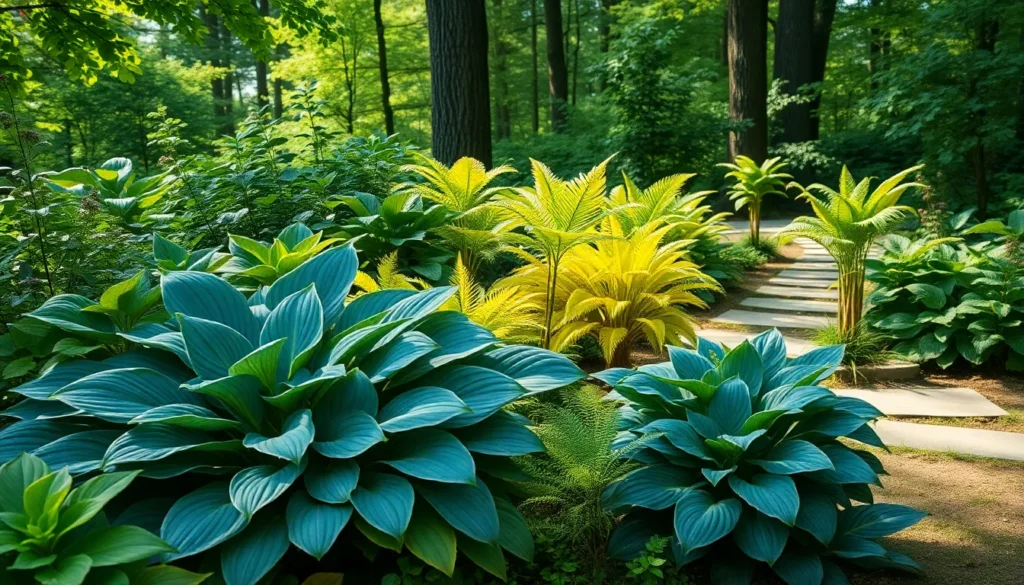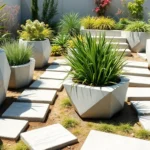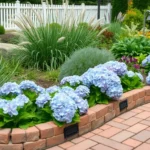We’ve all admired those stunning shade gardens that seem to glow with lush foliage and sophisticated charm. The secret? Hostas – nature’s perfect solution for transforming dim corners into breathtaking garden showcases. These versatile perennials don’t just tolerate shade; they absolutely thrive in it.
Creating a captivating hosta garden isn’t about randomly planting these leafy beauties and hoping for the best. It’s about understanding how different varieties work together to create texture, color, and visual impact that lasts from spring through fall. Whether you’re working with a small urban courtyard or expansive woodland areas, hostas offer endless possibilities.
We’re here to share proven design strategies that’ll help you maximize your shade garden’s potential. From selecting the perfect hosta combinations to creating dramatic focal points, you’ll discover how to transform any shaded space into a garden that neighbors will envy and visitors will remember.
Create a Shaded Woodland Retreat With Mixed Hosta Varieties
Transform your shaded garden space into a serene woodland sanctuary by strategically combining different hosta varieties. This approach creates natural depth and visual interest that mimics forest understory plantings.
Choose Complementary Hosta Size and Colors
Giant hostas like ‘Sum and Substance’ and ‘Empress Wu’ serve as dramatic anchor plants that command attention in your woodland retreat. Position these specimens measuring 4-6 feet wide at key focal points where their massive leaves create stunning backdrops for smaller varieties.
Medium sized hostas including ‘June’ and ‘Patriot’ work perfectly as transition plants between your giant specimens and compact varieties. We recommend spacing these 2-3 foot varieties throughout the middle ground to establish visual flow and prevent abrupt size changes.
Miniature hostas such as ‘Blue Mouse Ears’ and ‘Pandora’s Box’ add delicate finishing touches along pathway edges and between larger plantings. These tiny treasures rarely exceed 8 inches in height but provide essential detail work that makes your woodland design feel complete.
Color combinations create the most striking visual impact when you pair blue green hostas like ‘Halcyon’ with golden varieties such as ‘August Moon’. Variegated selections including ‘Fire and Ice’ and ‘Liberty’ bridge the gap between solid colored plants while adding sophisticated contrast patterns.
Layer Different Textures and Leaf Patterns
Smooth leaved varieties like ‘Royal Standard’ and ‘Fragrant Bouquet’ provide clean backdrops that highlight more textural companions. These glossy surfaces catch and reflect available light in shaded areas while creating visual breathing room between busier patterns.
Heavily textured hostas including ‘Abiqua Drinking Gourd’ and ‘Blue Angel’ add dimensional interest through their deeply ribbed and puckered leaf surfaces. We position these sculptural varieties where morning or filtered light can emphasize their pronounced texturing.
Heart shaped leaves from varieties like ‘Love Pat’ and ‘Big Daddy’ offer classic hosta silhouettes that anchor your design with familiar forms. Round leaved selections such as ‘Sum and Substance’ create bold geometric contrast when planted nearby.
Narrow and lance shaped foliage from hostas like ‘Lancifolia’ and ‘Undulata Albomarginata’ introduce linear elements that break up the dominance of broad leafed varieties. These upright growers add vertical interest while maintaining the woodland’s natural informality.
Add Natural Mulch and Stone Pathways
Shredded hardwood mulch creates the perfect woodland floor appearance while suppressing weeds and retaining soil moisture around your hosta plantings. Apply 2-3 inches of aged mulch annually, keeping it pulled back from plant crowns to prevent crown rot issues.
Flagstone pathways wind naturally through your hosta woodland retreat, connecting viewing areas while protecting soil from foot traffic compaction. We recommend using irregularly shaped stones in gray or tan colors that complement rather than compete with your foliage displays.
Pine needle mulch works exceptionally well under acid loving hostas and creates an authentic forest floor appearance. This organic material breaks down slowly while maintaining soil acidity levels that many hosta varieties prefer.
River rock borders define pathway edges and create subtle transitions between planted areas and walking surfaces. Choose stones ranging from 2-4 inches in diameter for the most natural appearance that won’t overwhelm your delicate hosta foliage patterns.
Design a Modern Minimalist Hosta Display
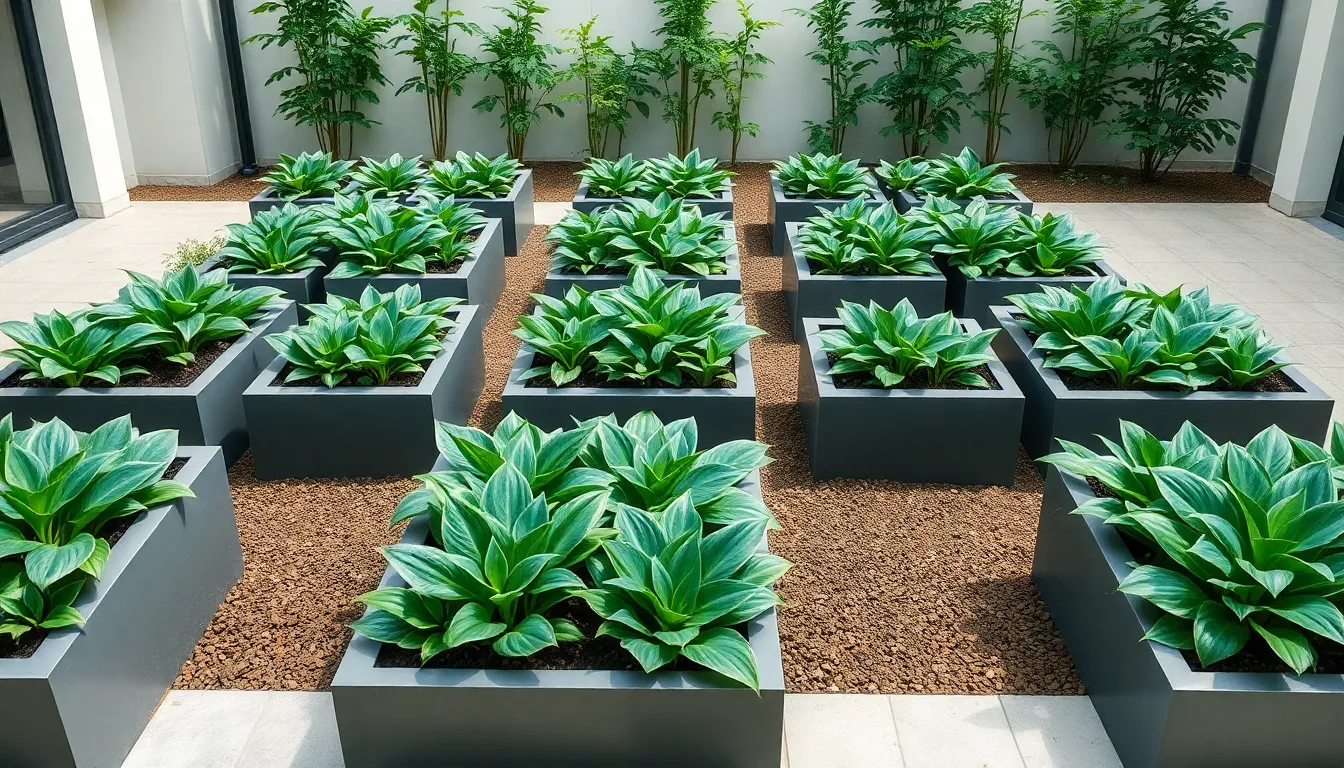
Modern minimalist hosta displays offer a striking departure from traditional woodland gardens. Clean lines and intentional spacing create sophisticated outdoor spaces that showcase the architectural beauty of these shade perennials.
Select Uniform Hosta Cultivars for Clean Lines
Uniform hosta cultivars form the foundation of any successful minimalist design. We recommend choosing one primary variety like ‘Elegans’ to create expansive blue-green foliage displays that maintain visual consistency throughout your space. This approach eliminates visual clutter while highlighting each plant’s natural form and texture.
Repeating the same hosta variety across different garden zones creates powerful continuity. Strategic placement of 3 to 5 identical specimens in grouped clusters amplifies their visual impact compared to scattered single plantings. Color consistency becomes particularly important when designing modern landscapes that rely on subtle variation rather than dramatic contrast.
Incorporate Geometric Planting Patterns
Geometric patterns transform traditional hosta beds into contemporary garden art. We’ve found that arranging hostas in precise circles, squares, or triangular formations creates sophisticated visual rhythm that complements modern architecture. These structured layouts work exceptionally well as focal points underneath mature shade trees or along property boundaries.
Linear arrangements offer another powerful geometric approach for modern hosta displays. Straight rows of uniform hostas can define garden edges or create natural borders between different industry zones. Angular spacing between plants maintains the clean aesthetic while allowing each specimen adequate growing room.
Use Contemporary Containers and Raised Beds
Contemporary containers elevate hostas both literally and aesthetically in modern garden designs. We prefer sleek rectangular planters or cylindrical vessels that complement the plant’s architectural form without competing for attention. Varying container heights adds dimensional interest while maintaining the minimalist principle of intentional simplicity.
Raised beds offer permanent answers for modern hosta displays with superior drainage and defined boundaries. Steel, concrete, or composite materials create sharp edges that contrast beautifully with soft hosta foliage. These elevated growing spaces also provide better soil control and easier maintenance access for long-term garden success.
Strategic container placement allows seasonal rearrangement to refresh your minimalist design throughout the growing season. This versatility lets us experiment with different spatial relationships while preserving the overall clean aesthetic that defines modern hosta gardens.
Build a Colorful Hosta Border Garden
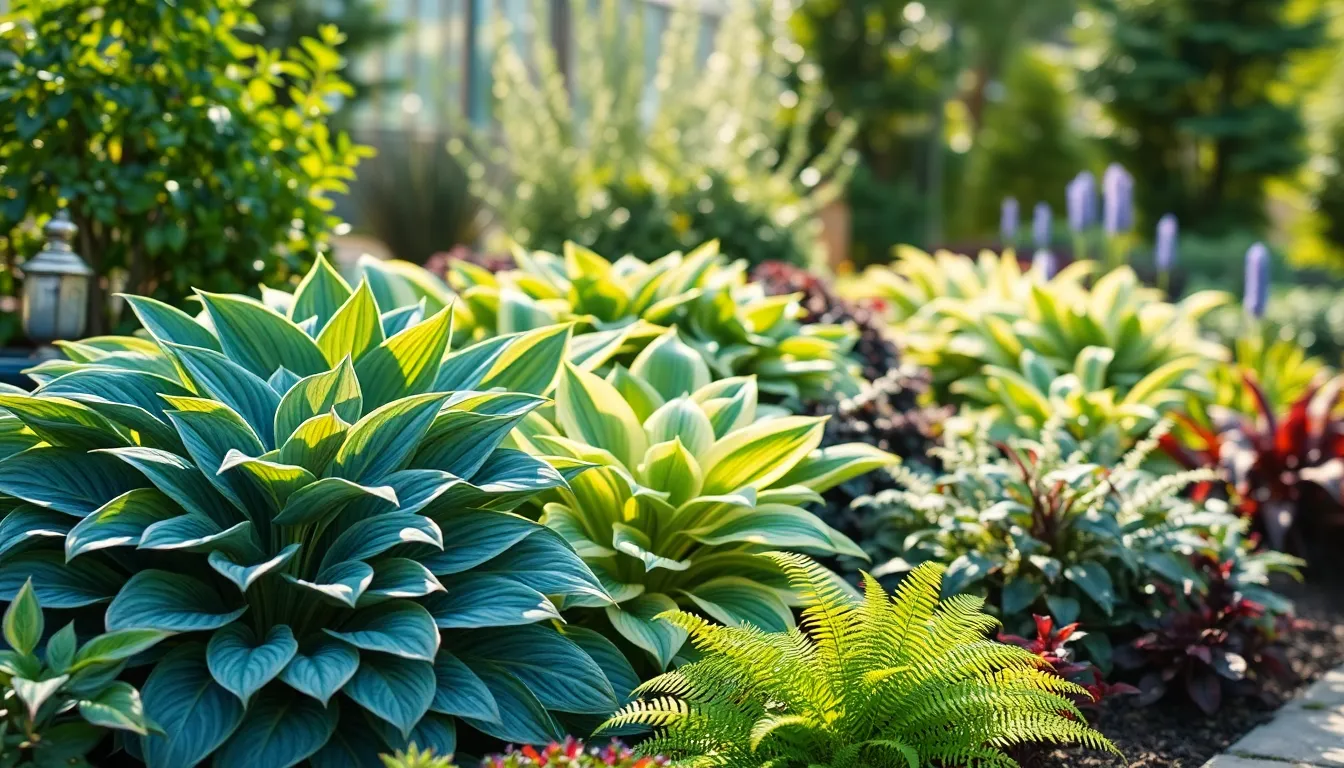
We’ll create stunning visual impact by strategically combining different hosta types in your border design. This approach maximizes color diversity while maintaining garden harmony throughout the growing season.
Combine Blue, Green, and Variegated Varieties
Group three to five plants of the same variety together to establish strong visual anchors along your border. Clustering identical hostas prevents a scattered appearance while creating bold statements that draw the eye naturally through your garden space.
Alternate blue or green leafed hostas with variegated types to maintain visual cohesion throughout your border design. This strategic placement guides viewers along the garden path while preventing the chaotic appearance that occurs when too many variegated varieties compete for attention in one area.
Mass a single bold variegated hosta among solid color varieties to create an instant focal point within your border. This technique transforms ordinary garden sections into memorable destinations while highlighting the unique characteristics of your chosen centerpiece plant.
Repeat exact color motifs throughout the garden to enhance unity and encourage natural movement through your border space. Strategic repetition connects distant garden areas while reinforcing your overall design theme across the entire planting scheme.
Plan for Seasonal Color Progression
Choose hostas with features that change across seasons to maintain visual interest from spring through fall. Spring chartreuse shoots that mature into deep blue or green foliage provide ever-changing color transitions that keep your border garden captivating throughout the growing period.
Time flower emergence for mid to late summer color when most shade plants have finished their peak blooming periods. Hosta flowers extend your garden’s seasonal appeal while adding vertical interest above the distinctive foliage displays.
Pair hostas with woodland groundcovers or perennials that bloom at different times to ensure year round visual appeal. This layered approach creates multiple seasons of interest while maximizing the color potential of your shaded border space.
Edge With Low-Growing Companion Plants
Select shade tolerant companions like ferns, Heuchera, or Tiarella to soften border edges while highlighting hosta height and foliage characteristics. These low growing plants create smooth transitions between your hosta displays and surrounding garden areas.
Add hardscape elements such as pathways or defined edging to provide structural anchors for your garden design. These permanent features give your border professional polish while creating clear boundaries between planted areas and circulation spaces.
Use coral bells and foamflower varieties to introduce complementary textures that enhance rather than compete with your hosta collection. These proven shade performers offer reliable performance while supporting your border’s overall color and seasonal progression goals.
Establish a Water Feature Hosta Sanctuary
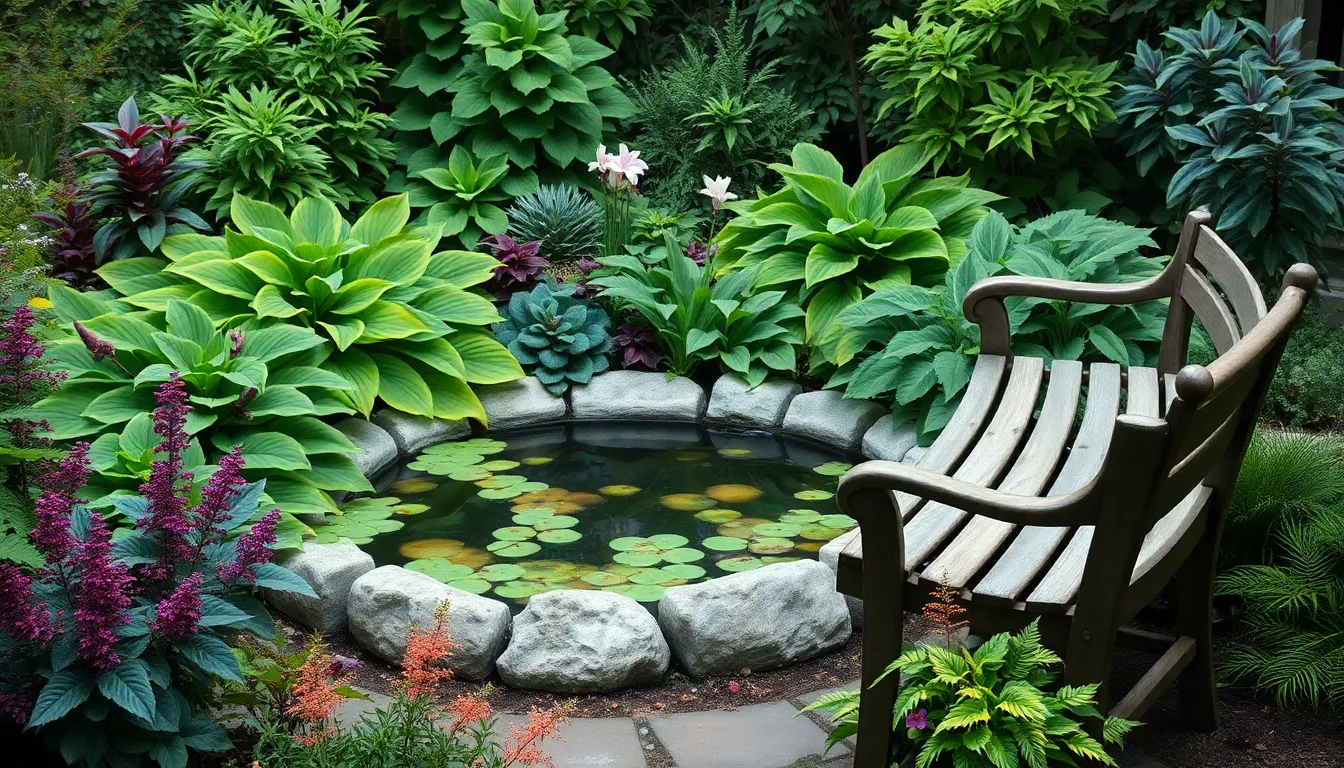
Water features transform ordinary hosta gardens into tranquil sanctuaries that captivate both gardeners and wildlife. Incorporating elements like small ponds or fountains creates soothing environments while providing the moisture hostas crave for optimal growth.
Position Moisture-Loving Hosta Species Near Water
Positioning hostas around water features maximizes their natural preference for consistently moist soil conditions. Species like ‘Sum and Substance’ and ‘Empress Wu’ thrive when planted within three to five feet of pond edges or fountain areas. Water proximity ensures these moisture-loving varieties receive adequate hydration through natural evaporation and occasional splashing.
Spacing hostas at proper intervals around water features prevents overcrowding while maintaining lush appearances. Large varieties need four to six feet between plants, while medium-sized hostas require two to three feet of spacing. Strategic placement creates natural-looking groupings that mirror how hostas grow in their woodland habitats.
Create Natural Transitions With Ferns and Astilbe
Ferns complement hostas perfectly by sharing similar moisture and shade requirements while adding textural variety to water feature surroundings. Royal ferns and ostrich ferns work particularly well near ponds because they tolerate wet conditions and create feathery backdrops for bold hosta foliage. Astilbe varieties like ‘Bridal Veil’ and ‘Fanal’ contribute colorful flower spikes that contrast beautifully with hosta’s broad leaves.
Layering these companion plants at different heights creates natural transitions from water to garden beds. Place tall ferns behind large hostas, medium astilbe between hosta clumps, and low-growing varieties like painted ferns as ground-level accents. This graduated approach mimics natural woodland settings where plants naturally layer themselves based on light and moisture availability.
Design Reflective Views and Seating Areas
Reflective surfaces double the visual impact of hosta plantings by creating mirror images that enhance the garden’s perceived size and beauty. Small ponds positioned strategically allow visitors to see both direct plantings and their reflections simultaneously. Water surfaces act as natural mirrors that showcase the intricate patterns and colors of variegated hosta leaves.
Seating areas positioned near water features provide comfortable vantage points for appreciating the garden’s tranquil atmosphere. Benches placed six to eight feet from pond edges offer optimal viewing angles while remaining accessible via stone or mulched pathways. Adding hardscape elements like flagstone patios creates stable, all-weather seating areas that complement the natural beauty of hostas and water features.
Strategic lighting extends enjoyment into evening hours when water features create particularly magical atmospheres. Solar-powered spotlights illuminate key hosta specimens while underwater LED lights make water features glow softly after dark.
Craft a Container Hosta Garden for Small Spaces
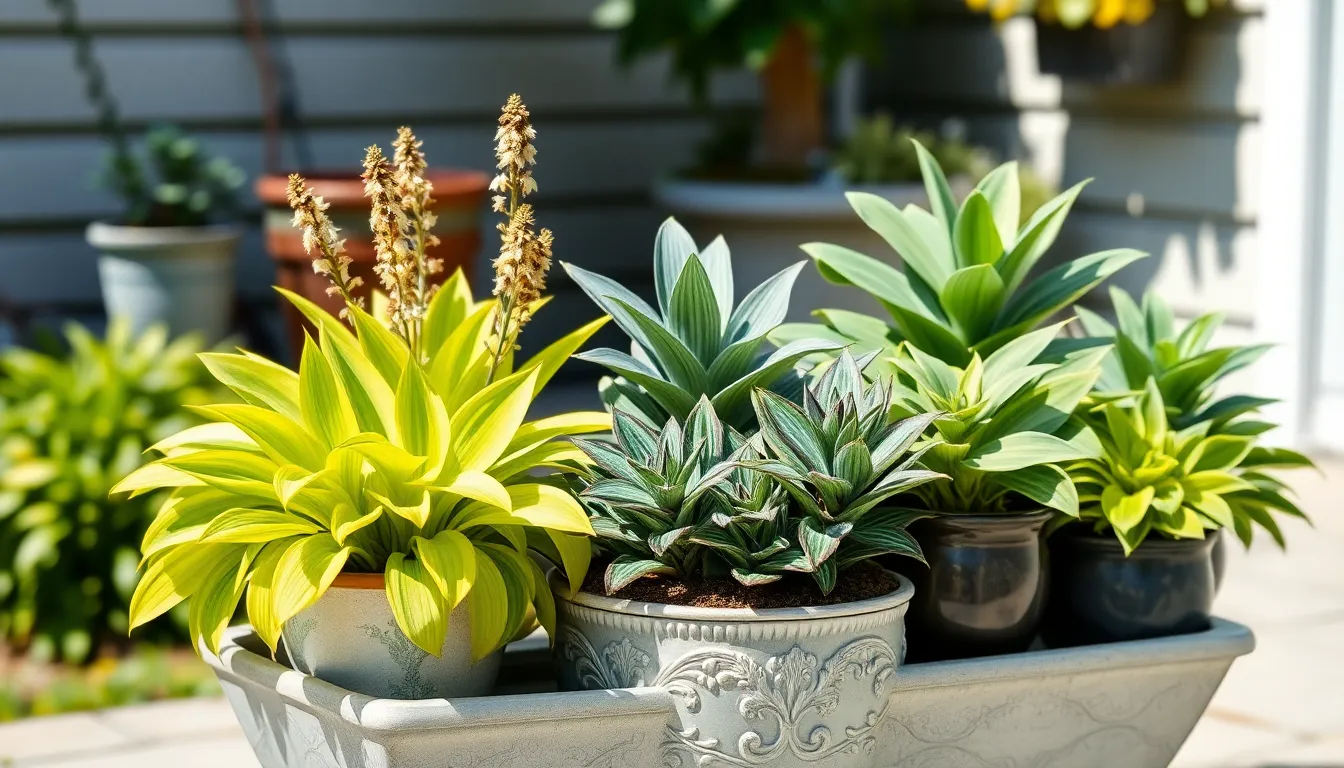
Container gardening opens up exciting possibilities for showcasing hostas even when yard space is limited. We can create stunning displays that bring the beauty of these shade perennials to patios, balconies, and small outdoor areas.
Choose Compact Hosta Varieties for Pots
Miniature hostas deliver maximum impact in minimal space while staying perfectly proportioned in containers. We recommend selecting varieties like ‘Shiny Penny’, ‘Green Eyes’, and ‘Itsy Bitsy Spider’ that grow only a few inches tall and won’t outgrow their pots over time. These compact cultivars maintain their petite size throughout the growing season while offering the same attractive foliage patterns as their larger counterparts.
Dwarf varieties also provide better container stability since their root systems match the pot dimensions more appropriately. We’ve found that choosing hostas specifically bred for small spaces prevents the need for frequent repotting and maintains healthier plants overall.
Arrange Multi-Level Container Displays
Creating visual depth transforms a simple container collection into an captivating garden display. We can achieve this by using containers of varying heights, placing smaller pots on top of larger ones, or incorporating tiered planters that naturally create elevation changes.
Multi-level arrangements allow us to showcase different hosta varieties at their optimal viewing angles while maximizing our growing space. Positioning taller containers in the back and shorter ones in front creates a natural amphitheater effect that highlights each plant’s unique characteristics.
Strategic placement of containers at different levels also improves air circulation around the plants and makes maintenance tasks like watering and deadheading more accessible.
Ensure Proper Drainage and Soil Requirements
Adequate drainage prevents the waterlogged conditions that can quickly kill container hostas. We must ensure every pot has sufficient drainage holes in the bottom, and we often add a layer of gravel or broken pottery to improve water flow.
Well-draining potting soil provides the foundation for healthy root development and prevents the root rot that commonly affects container plants. We avoid using garden soil in pots since it compacts too easily and doesn’t provide the aeration that container plants need.
| Container Requirement | Specification |
|---|---|
| Drainage holes | Multiple holes, minimum ½ inch diameter |
| Soil type | Well-draining potting mix |
| Container depth | Minimum 8-10 inches for dwarf varieties |
| Watering frequency | Daily during hot weather |
Regular monitoring of soil moisture helps us maintain the consistent conditions that container hostas require, especially during summer heat when pots dry out more quickly than ground plantings.
Develop a Fragrant Hosta Evening Garden
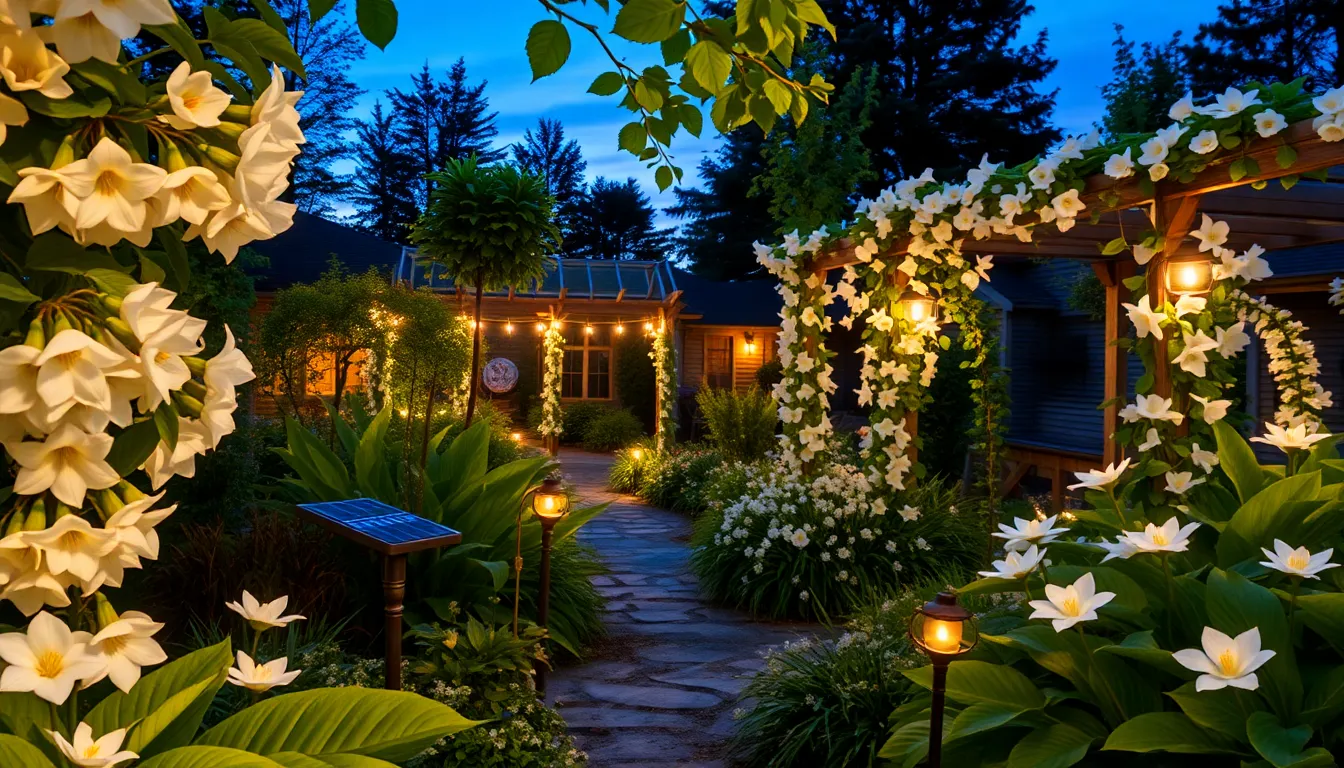
Creating a fragrant hosta evening garden transforms your outdoor space into a sensory retreat perfect for relaxation after sunset. We’ll explore how to combine aromatic hostas with strategic companion plants and lighting to maximize your garden’s evening appeal.
Feature Fragrant Hosta Plantaginea Varieties
Hosta plantaginea stands out as the premier fragrant variety for evening gardens, producing intensely fragrant white flowers that bloom in late summer. This species opens its trumpet-shaped blooms in late afternoon and evening, releasing a sweet lily-like fragrance that attracts night pollinators. We recommend planting multiple specimens in clusters of three to five plants to amplify the fragrance impact throughout your evening garden space.
Positioning these fragrant hostas near seating areas or walkways maximizes your sensory experience during evening garden visits. The white flowers of Hosta plantaginea provide visual brightness in twilight conditions while their fragrance intensifies as temperatures cool. Plant them in partial shade locations where they’ll receive morning sun but remain protected during harsh afternoon heat for optimal bloom production.
Add Night-Blooming Companion Plants
Moonflowers create spectacular white trumpet blooms that unfurl as darkness falls, perfectly complementing the evening fragrance of your hostas. These vigorous climbing vines produce 6-inch diameter flowers that open with dramatic speed each evening, creating a mesmerizing garden spectacle. We suggest training moonflowers on trellises or arbors positioned behind your hosta plantings for vertical interest and enhanced fragrance layering.
Evening primrose contributes delicate yellow blooms that open at dusk, releasing a sweet lemon scent that blends beautifully with hosta fragrances. These hardy perennials self-seed readily and create naturalized colonies that expand your fragrant garden coverage over time. Plant evening primrose in slightly sunnier spots near the edges of your hosta groupings where they’ll receive adequate light for blooming.
Night-blooming jasmine provides one of the most potent evening fragrances, with small white flowers that release an intoxicating perfume after sunset. This shrub works exceptionally well as a backdrop plant behind your hosta borders, creating fragrance depth and visual structure. Position jasmine where prevailing evening breezes will carry its scent across your entire garden space for maximum impact.
Install Subtle Lighting for Evening Enjoyment
Solar-powered pathway lights create gentle illumination along garden walkways without overwhelming the natural evening ambiance of your fragrant hosta garden. These energy-efficient fixtures charge during daylight hours and automatically illuminate at dusk, providing safe navigation while highlighting your carefully planned plant combinations. We recommend spacing solar lights every 6 to 8 feet along main pathways for optimal coverage and visual appeal.
String lights draped through tree branches or along fencing add magical ambiance to your evening hosta garden without harsh glare that might detract from the natural beauty. Choose warm white LED string lights for energy efficiency and longevity, creating a soft glow that enhances rather than competes with your fragrant plantings. Position string lights at varying heights to create depth and visual interest throughout your garden space.
Uplighting strategically placed near specimen hostas showcases their architectural form during evening hours while providing subtle background illumination. Low-voltage LED spotlights positioned at ground level create dramatic shadow patterns on walls or fencing behind your plants. Focus uplighting on your largest fragrant hostas and key companion plants to create focal points that draw visitors deeper into your aromatic evening garden sanctuary.
Transform Slopes With Cascading Hosta Arrangements
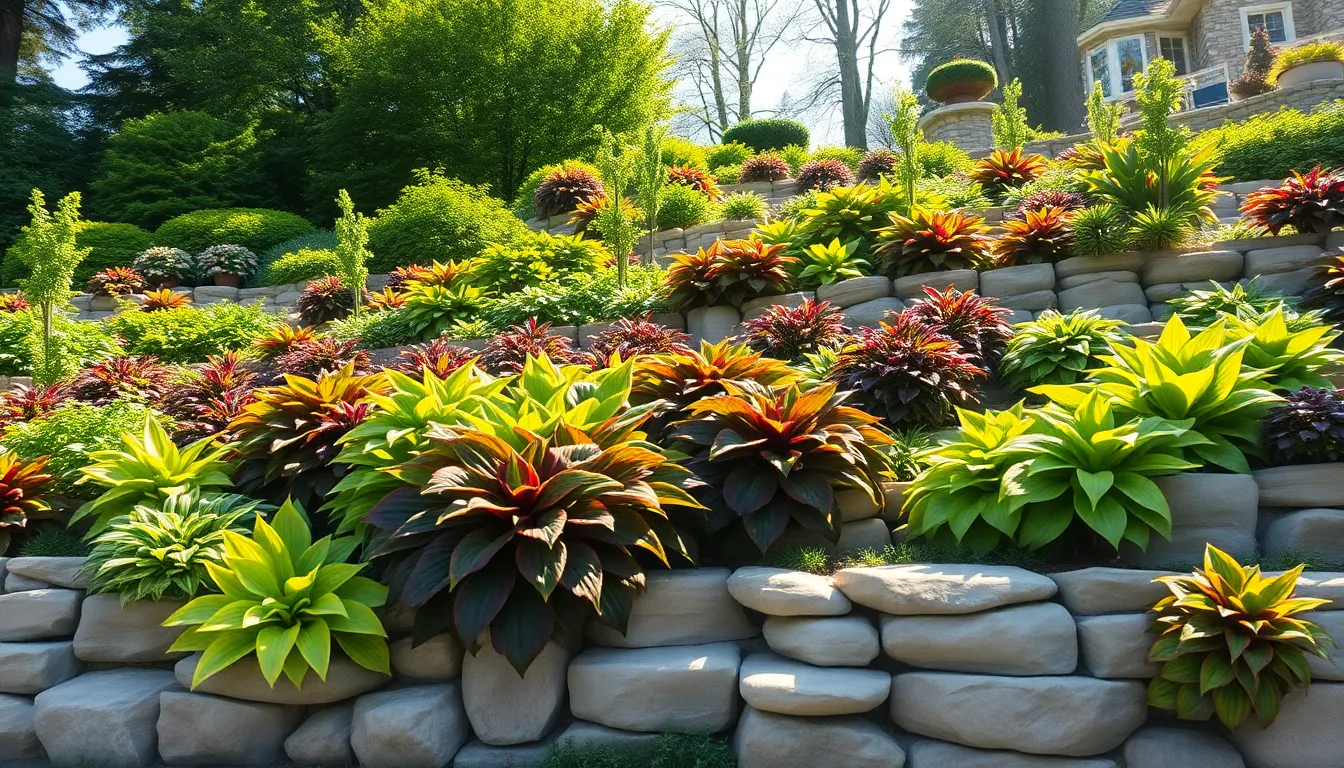
Slopes present unique opportunities to showcase hostas’ natural beauty through layered plantings that follow your industry’s natural contours. Cascading arrangements create visual flow by positioning taller hosta varieties behind shorter ones, mimicking the appearance of flowing water down your slope.
Select Spreading Hosta Varieties for Ground Cover
Vigorous spreading varieties like ‘Halcyon’, ‘Patriot’, and ‘Francee’ excel at filling large slope areas while suppressing weeds naturally. These cultivars establish quickly and create uniform coverage that transforms bare slopes into lush displays. We recommend mixing different leaf shapes and colors within your spreading selections to add visual interest while maintaining consistent ground coverage.
Combine blue-leafed ‘Halcyon’ with gold-edged ‘Patriot’ for striking color contrast that catches light at different angles throughout the day. Plant these varieties in overlapping drifts rather than rigid rows to create organic transitions between different hosta types. Space plants closer together on steeper slopes to achieve faster coverage and better erosion control.
Create Terraced Planting Levels
Terracing maximizes your planting space while improving accessibility for maintenance and garden enjoyment. Each level accommodates different hosta varieties, allowing you to organize displays by height, texture, or color themes. We suggest creating three to four distinct levels on moderate slopes, with each terrace hosting complementary hosta groupings.
Build retaining walls using natural stone or timber to define each planting level and prevent soil migration. Position giant hostas like ‘Sum and Substance’ on upper terraces where their dramatic foliage creates strong focal points. Place medium varieties in middle tiers and reserve lower levels for miniature hostas that provide detailed interest at eye level.
Prevent Erosion With Strategic Root Systems
Hostas’ fibrous root networks naturally stabilize soil and prevent erosion on challenging slope terrain. Dense plantings create interlocking root systems that anchor your industry while supporting surrounding soil structure. We recommend combining hostas with other shade-loving perennials like astilbe and heuchera to strengthen erosion prevention.
Plant hostas in wide, deep holes that accommodate their spreading root systems and promote strong anchoring. Space plants closer together on steeper grades where erosion risk increases, typically 18 to 24 inches apart instead of standard 30-inch spacing. This denser arrangement accelerates ground coverage while providing immediate slope stabilization benefits.
Design a Four-Season Hosta Interest Garden
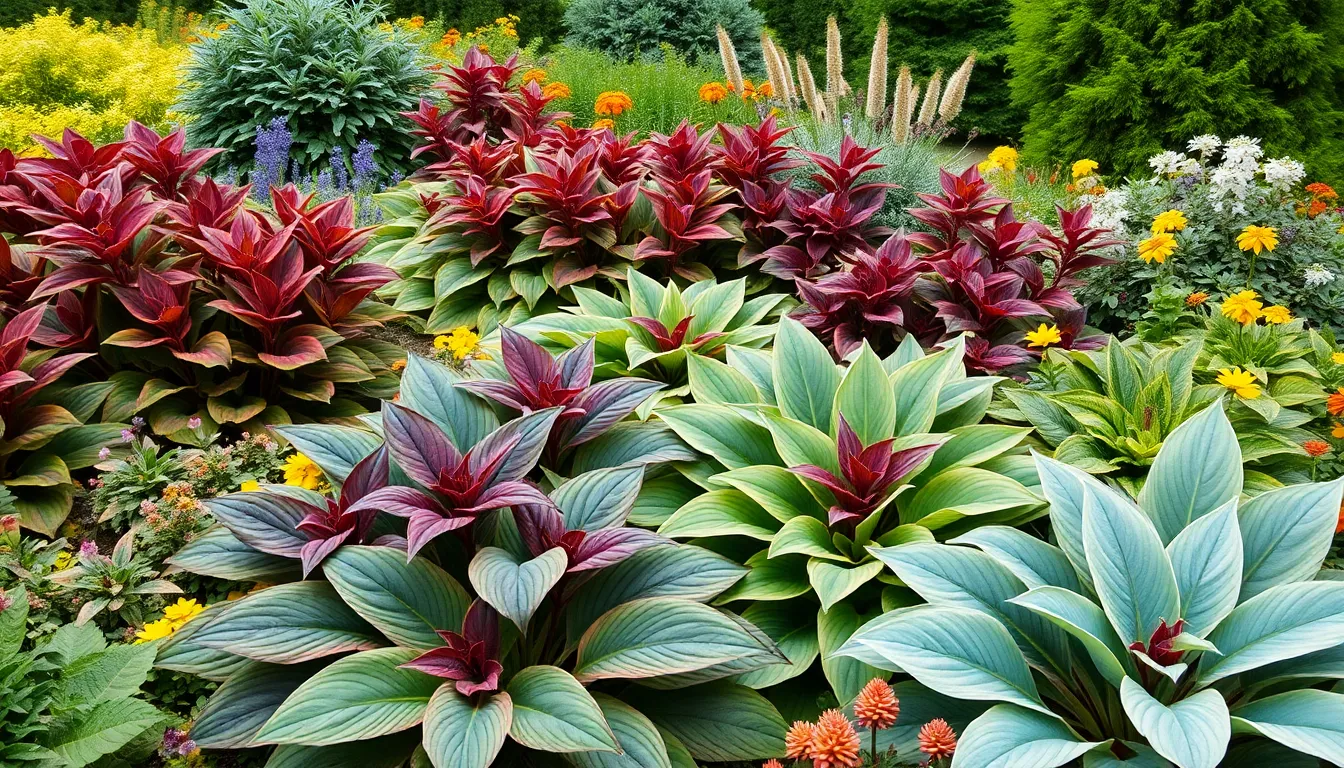
Creating a four season hosta garden extends your industry’s appeal far beyond the typical summer growing period. We’ll transform your shade space into a year round showcase that maintains visual interest through strategic plant selection and thoughtful design combinations.
Plan for Spring Emergence and Summer Blooms
Select hostas with varying leaf colors and sizes to create ever-changing visual layers throughout the growing season. ‘H. sieboldiana Elegans’ delivers stunning powdery blue leaves that emerge early, while ‘Wide Brim’ and ‘Carolina Sunshine’ provide bright yellow variegation that intensifies as temperatures warm.
Pair hostas with spring blooming companions like bulbs or lungwort to bridge the gap between winter dormancy and full summer foliage. These early performers ensure our garden maintains color and interest while hostas slowly unfurl their distinctive leaves.
Layer summer blooming perennials throughout your hosta plantings to maintain continuous seasonal color. Coneflowers and phlox create stunning vertical accents above hosta foliage while extending bloom time through late summer months.
Incorporate Evergreen Structure Plants
Add evergreen companion plants like boxwood or holly to provide essential year round structure that contrasts beautifully with hostas’ seasonal foliage changes. These permanent fixtures anchor our design when hostas enter winter dormancy.
Include ornamental trees such as Japanese maples for their exceptional year round interest and spectacular fall color transitions. Their branching patterns create architectural elements that complement hosta plantings while providing necessary shade coverage.
Position evergreen shrubs strategically to frame key garden views and create backdrop elements that highlight your hostas’ seasonal transformations throughout the year.
Add Winter Interest With Seed Heads and Bark
Incorporate plants with persistent seed heads such as coneflowers or sedums to maintain visual appeal during winter months when hostas have retreated underground. These structural elements provide texture and form against snow covered landscapes.
Choose trees with attractive bark features like birch or ninebark to add compelling visual interest during the dormant season. Their distinctive bark patterns create focal points that draw attention through bare winter months.
Use ornamental grasses for their exceptional winter texture and graceful movement in cold weather breezes. These plants maintain their structural integrity while adding ever-changing elements to our four season hosta design.
Conclusion
We’ve explored countless ways to transform your shaded spaces into stunning hosta displays that’ll make your neighbors stop and stare. From creating serene woodland retreats to modern minimalist designs these versatile plants offer endless possibilities for every gardening style and space constraint.
Whether you’re working with sprawling borders cascading slopes or compact containers the key lies in thoughtful planning and strategic plant selection. Remember that hostas aren’t just about summer foliage – with proper companion planting and seasonal considerations you can maintain visual interest throughout the entire year.
Your hosta garden journey starts with understanding your space and choosing the right varieties for your exact conditions. We’re confident these ideas will help you create the shade garden of your dreams.
Frequently Asked Questions
What makes hostas ideal for shade gardens?
Hostas thrive in shaded conditions where many other plants struggle, making them perfect for transforming dim garden areas. They offer incredible variety in size, color, and texture, from giant anchor plants to delicate miniatures. Their versatility allows gardeners to create stunning displays with striking foliage combinations that provide visual interest throughout the growing season.
How do I create effective color combinations with hostas?
Pair blue-green hostas with golden varieties for striking visual impact. Group 3-5 plants of the same variety to create strong visual anchors, then alternate blue or green-leafed hostas with variegated types for cohesion. Layer different textures and leaf patterns to add depth, using smooth-leaved varieties for contrast against heavily textured hostas.
What companion plants work well with hostas?
Ferns and astilbe complement hostas beautifully, especially around water features. Woodland groundcovers and perennials provide year-round interest in border gardens. For evening gardens, pair fragrant hostas with night-blooming plants like moonflowers and evening primrose. Low-growing companion plants help soften border edges and create natural transitions.
Can hostas be grown in containers?
Yes, hostas excel in container gardening for patios and balconies. Choose compact varieties for pots, ensuring proper drainage and quality soil. Create multi-level container displays to enhance visual depth and improve air circulation. This approach offers flexibility for seasonal rearrangement while maintaining attractive displays in small spaces.
How do I design a modern minimalist hosta garden?
Select uniform hosta cultivars like ‘Elegans’ for visually consistent displays. Use geometric planting patterns including circles, squares, and linear arrangements. Maintain intentional spacing with clean lines to showcase the architectural beauty of hostas. Repeat the same variety across different garden zones for continuity and contemporary aesthetic appeal.
What’s the best way to use hostas on slopes?
Create layered plantings that follow natural contours for visual flow. Use vigorous spreading varieties like ‘Halcyon’ and ‘Patriot’ for effective ground cover. Install terraced planting levels with retaining walls to maximize space and improve accessibility. Dense plantings help prevent erosion through hostas’ fibrous root systems.
How can I maintain year-round interest in my hosta garden?
Plan for spring emergence with early-blooming companions and layer summer-blooming perennials for extended color. Include evergreen plants and ornamental trees for winter structure. Add plants with persistent seed heads and attractive bark features. This strategic selection ensures visual appeal throughout all four seasons.

